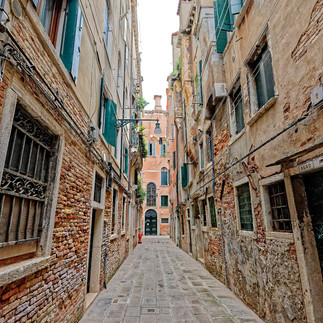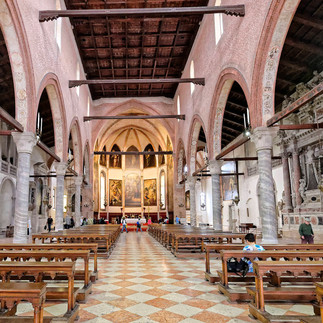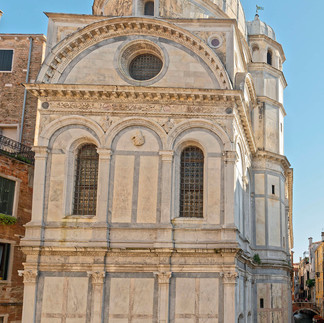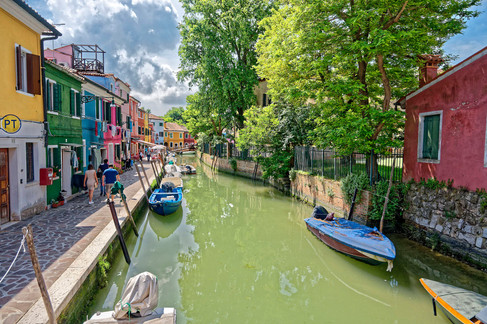Venice June 2024 - Travel Diary
- Philippe Rideau
- Jan 12
- 8 min read
Updated: Jan 13

1rst day





2nd day
On this Friday morning, the sun is out, giving Venice a different face, the colors are shimmering. We head towards the Piazza (Saint Mark's Square), the vendors of the Rialto are busy setting up their souvenir stalls after having pulled their carts through the narrow streets and climbed the stairs to the bridge. The tourist crowd is already significant despite the early hour
This morning we booked a guided tour called "Itinerari Segreti" (secret itinerary) in the Doge's Palace


While waiting for our French-speaking guide, we stroll through the inner courtyard of the palace and admire its "Venetian Gothic" architecture. Note the impression of lightness that the building gives off. This impression is due to the architectural process: the inversion of masses. This technique places the full volumes on the upper level, while the lower galleries benefit from a great finesse of decoration.
We begin our guided tour with the rooms located above the ceremonial rooms. These rooms were intended for the administration of the Duchy of Venice, office for notaries, archive room. Note the particular shape of the door hinges, designed to support the variations of the terrazzo floor
We descend from the attic to arrive in the ceremonial rooms through a hidden door. The contrast between the functional administrative part and the richly decorated rooms is striking! We cross these rooms to go to the prison located in the basements of the palace, more humid than the prison of Plombs… We take the opportunity to admire all the works showing the wealth of this republic.
We pass through the cells under the palace to reach the bridge of sighs which connected the premises of the investigating judges of the Doge's Palace to the new prisons.
After this unusual visit to the Doge's Palace, far from the tourist crowds, we head to the San Polo district via the Rialto Bridge to visit the Basilica di Santa Maria Glorosia Dei Frari, according to some guides one of the churches containing the greatest masterpieces of Venice. But before this visit, we eat in a small osteria: Ai4 Feri Storti, located outside the tourist sites, we enjoy a typical Venetian cuisine with market products.
After regaining our strength, we walk to the Campo Dei Frari where we discover the facade of the basilica rebuilt several times in red bricks with ornaments in white Istrian stone. Its square bell tower rises to 70m and is the second highest after that of San Marco.

The contrast between the simple classicism of the exterior architecture and the richness of the interior ornamentation is surprising. We do not know where to look, rood screen, tombs, altarpieces, paintings, everything is a wonder, but also a surprise; surprise between the style of Titian's tomb in classical style and the one opposite, tomb of the sculptor Canova, pyramid in neoclassical style, clashing in this decor. Also surprising, the baroque style for the tomb of the Doge Giovanni Pesaro with these black colossi supporting the capital, but helped by cushions.
We also admire the 124 stalls of the choir and the work of marquetry and sculpture of the backs.
At the back of the choir, above the altar, we can admire Titian’s Assumption. This first religious work by the artist surprised his contemporaries with its freedom of interpretation: the Virgin is not depicted imploring and with clasped hands, but rather as blossoming, graceful, with a gentle and serene face rising in a bath of light towards the human face of God the Father.

Another work by Titian: the altarpiece of the Madonna di Ca’Pesaro; here the artist also surprises his contemporaries by not placing the Virgin in the centre of the work. The work depicts Bishop Jacopo Pesaro and his family, who have come to thank the Virgin for a naval victory over the Turks (on the left, a turbaned figure). On the left, a figure looks at us and captures our attention.
Also a Virgin and Child in the midst of Franciscan monks, painted by Bernardino Licinio around 1535
After this day of visits, we went to the Fenice to attend a concert in this historic place. We had booked our seats for three months already, limited choice, since only seats for Beethoven's 9th symphony were available. It was performed by the orchestra and choirs of the Fenice, under the direction of Daniele Rustioni; soprano Ana Maria Labin mezzosoprano Veronica Simeoni tenor Francesco Demuro bass Adolfo Corrado. We had a great time, among the many Venetian subscribers
3rd day
After checking the weather forecast which predicts a beautiful spring day we plan to go visit the island of Lido. We take the vaporetto, line 1 at Rialto to the Lido.
We delight again and again in this journey in the heart of the city, on the Grand Canal, enjoying the beauty of each palazzo.

We arrive at the lido in the middle of the morning, the sun is shining and we decide to head towards the coast where the beaches are. The atmosphere is totally different from that of Venice. Recent buildings or a little older but in poor condition. The reality is very far from the image we had of the island welcoming the glitterati and stars of the Mostra.


After a decent lunch on the Lido Island we return to the Serenissima and decide to go for a stroll in the Castello district. We stop to visit the church of San Zaccaria. In the chapel of San Atanasio we admire David conquering Goliath by Palma the Younger and also The Nativity of John the Baptist by Tintoretto; However, according to art critic Andrea Gallo, this name is a mistake. According to Gallo, the symbolism used by Tintoretto in the painting of San Zaccaria is that of the birth of the Virgin and can in no way refer to the birth of the Baptist.
The way Tintoretto painted the mother of the Virgin is also very captivating and very modern. All the art and talent of Tintoretto are present in this work.
We then visit the chapel of San Tarasio. Presbytery that became the apse of the old church, its construction dates back to the 14th century, on the foundations of the first construction of the 9th century. We can admire 3 superb triptychs:
the triptych of the Virgin, the Virgin enthroned and the child flanked on the left by Saint Blaise and on the right by Saint Martin dates from 1385 and is by the painter Stefano di Sant'Agnese; the triptych of the Body of Christ or the Sepulchre, painting from 1433 by Antonio Vivarini and Giovanni d'Alemagna and finally the triptych of Santa Sabina, painting from 1443 by the same artists.
We then go down into the crypt which as most of the time is invaded by the waters of the lagoon.
Still in the Castello district, a few dozen meters from the Palazzo Grimani, we discover the Campo Santi Giovani e Paolo. On this campo, there is the Basilica of the same name, and more surprisingly, next to the basilica is Ospedale SS. Giovanni e Paolo Pronto Soccorso, in other words, the hospital for emergencies!

At the end of the afternoon, we return to our base camp, discovering new wonders. Passing from the Castello district to the Canaregio district, we discover the church of Santa Maria dei Miracoli. This 15th century church built by Lombardo, in the Italian Renaissance style, whose facade is covered in polychrome marble, is a pure marvel.
4th day
For this last day in Venice, we decide to visit the northern islands. We take line 12 at F.te Nove north of Cannaregio towards the island of Burano. We pass the stop for the island of Murano that we visited in 2011 and we stop at Burano. This island, with its multi-colored house facades, has not changed and enchants us as much as it did 13 years ago, except for the crowds that will swell as the hours go by on this sunny morning, many stars disembark tourists who have come for an hour or two. We therefore decide to leave Burano to go to the island of Torcello which contains architectural treasures. This island was the first to be inhabited in the lagoon and had up to 20,000 inhabitants, today just a few dozen souls populate it. On the other hand, there are a few good restaurants (we tested one) mainly frequented by Venetians on this Sunday.

On the island of Torcello, we visit the Cathedral of Santa Maria Assunta. Founded in 639, it is one of the oldest Veneto-Byzantine style buildings in the entire Adriatic. Inside, there is a superb polychrome mosaic flooring, in the Byzantine style. In particular, the masterpiece is the immense mosaic of the Last Judgement that covers the height of a wall. Made by Veneto-Byzantine master glassmakers in the 12th and 13th centuries, it tells scenes from holy history in 6 superimposed rows.
In the central apse, a very beautiful mosaic in the same Veneto-Byzantine style from the 11th century. It represents a hieratic Virgin, haloed in gold and dressed in blue, holding the baby Jesus in her arms. Below we find the twelve Apostles.

We are taking the plane early tomorrow Monday and sleeping this Sunday evening at the hotel near the airport, small incident in the morning that could have made us extend our stay, the hotel elevator got stuck for 1 hour with us inside, fortunately without consequences.
Our trip is coming to an end, the seduction of the Serenissima has worked again. Despite the very large crowd, we were able to find a certain tranquility in the maze of charming alleys far from the tourist "tropisms" and therefore discover new sites that are always so magical.















































































































































Comments